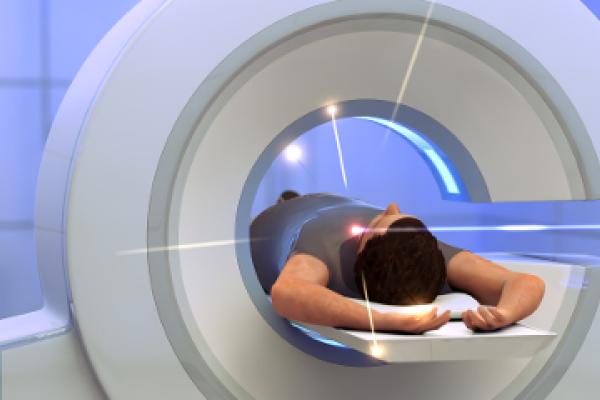Giant particle accelerators are best known for hunting exotic particles and probing the laws of physics, but they can also be used to treat cancer using a technique called hadron therapy.The technology hit newspaper headlines around the world in 2014 when Britons Brett and Naghmeh King took their son Ashya from a UK hospital and fled abroad in order for him to have hadron therapy, which was not available in Britain to treat his brain cancer.Hadron therapy relies on charged atoms that have been accelerated in vacuum rings to pack a punch of over 10 million electronvolts. The high velocity gives hadrons the extraordinary ability to fly through several centimetres of solid matter before stopping abruptly at a designated target area.Whereas X-rays used in conventional radiotherapy damage healthy and cancerous tissue alike as they journey through the body, hadron beams seep harmlessly through skin and vital organs, blasting almost all their energy into the tumour.‘One of the beauties of hadron therapy is that, by sparing the healthy tissue, you can also reduce long-term side-effects,’ said Professor Manjit Dosanjh, a biologist working at the CERN particle physics laboratory in Geneva, Switzerland.Over 100 000 cancer patients have already been treated by hadron therapy, and advances in the field could spread its merits to many more.The problem is that, while the energy of the particle beam can be controlled precisely, the density of the target cannot. Natural variations in human tissue can result in the beam diving further than planned into the body and destroying healthy cells.Even though the damage to nearby tissue is reduced compared to standard radiotherapy, there is still a risk. Unlike X-rays, the body does not reemit hadrons after they have delivered their payload, offering few indications as to where they landed.“‘The result is like taking all the sunlight shining down on earth and briefly focusing it on a pinhead.’Luca Stockhausen, PhD student at CLPU in Salamanca, SpainResearchers on the ENVISION project, coordinated by Prof. Dosanjh, are working around this problem by checking for by-products of the collision process – gamma radiation.Bombarded tissue sometimes emits high-energy photons which form gamma rays. Among the technologies developed during the project, one partner patented a gamma ray camera with a novel slit geometry that is now being tested at hadron therapy centres in Dresden and Philadelphia.AntimatterSometimes the interaction between the hadron beam and cancerous cells also releases antimatter particles called positrons. Positrons rapidly annihilate against nearby electrons in a signature flash of gamma rays that fly off in opposite directions.The researchers have worked out a way of using a PET scanner to pick this up, but only after modifying the way it works.‘The big challenge is to fire a hadron beam through the PET scanner during the measurements,’ said Marie Skłodowska-Curie grantee Dr Giancarlo Sportelli, at the University of Pisa, who also took part in the EU-funded ENVISION project.‘This produces gamma rays all over the place and swamps the signal in background noise.’PET scanners have been around for decades to detect the origin of gamma ray pairs and map body parts in 3D medical diagnostics.Dr Sportelli and his colleagues replaced analogue parts in the scanner with digital ones, optimised data processing algorithms, and designed new modular detectors that can follow millions of gamma rays per second.The adjustments are making it possible to distinguish spurious observations and could ultimately pinpoint the beam tip to within millimetres inside the patient’s body.Over 100 000 cancer patients have been treated by hadron therapy. Video Credit: CERN/ENLIGHT/ENVISION/ENTERVISION/PARTNER/ULICE/Nymus3dLasersAnother hurdle for hadron therapy is the size and cost of the machines. One way to solve this is by using lasers.It’s something that’s being helped by the efforts of the EU-funded LA3NET Initial Training Network, coordinated by Professor Carsten Welsch at the University of Liverpool.‘We are training young scientists to interface between laser and particle accelerator technology,’ said Prof. Welsch.Collaboration between these fields could prove a game changer in reducing the scale and price of the hadron accelerators.Luca Stockhausen, a LA3NET graduate student at the CLPU Pulsed Lasers Centre in Salamanca, Spain, is developing techniques to thrust beams of hadrons with lasers instead of particle accelerators.His trick is to concentrate the laser over split-second pulses and microscopic spots on a metal surface.‘The result is like taking all the sunlight shining down on earth and briefly focusing it on a pinhead,’ said Stockhausen. The beam sublimates the metal, stripping electrons from their atoms and propelling their nuclei at speeds comparable to those of the hadrons used to treat eye tumours today.Reaching the maximal power and the reproducibility of conventional particle accelerators may still require years of research, but Prof. Welsch is convinced that the prospects are worth the effort.‘At present, particle accelerators for hadron therapy are bulky and expensive,’ he said. ‘With the right advances, lasers could make them smaller and more affordable.’
This article was originally published in Horizon, the EU Research and Innovation magazine.
Add to favorites:
Favorite
Share:
Antimatter, gamma rays help steer giant cancer-killing machines
Listing Description
Documents
No documents available.
Ask KETMarket to make a contact
Connect with the Listing Owner!

Video
Related Funding and Finance Opportunities
Unlock Exclusive Funding Opportunities!

Upgrade to Premium now and never miss an important opportunity again! Already a premium member? Log in here to explore your matches.

